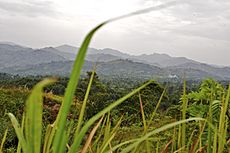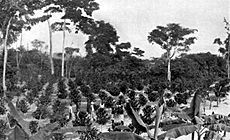Coffee production in Democratic Republic of the Congo facts for kids
Coffee is a very important crop in the Democratic Republic of the Congo (DRC). Most of the coffee farms are found near Lake Kivu. In 2013, over 11,000 farmers grew coffee in the country. They mainly grow two types of coffee beans: Robusta and Arabica.
Contents
Who Grows Coffee?
In 2013, more than 11,000 farmers were growing coffee in the DRC. These farmers often work with special groups called co-operative associations. Groups like Furaha, Muungano, and Sopacdi help farmers sell their coffee. They also help with getting the coffee to different places. These partnerships are very helpful for the farmers.
Types of Coffee Grown
Many kinds of coffee are grown in the DRC. The two main types are Robusta and Arabica.
Robusta Coffee
Robusta coffee is mostly grown in the northeastern parts of the country. You can find it in places like Isiro. It also grows in lower areas such as Ubangi, Uele, Kivu, Kasai, and Bas-Congo.
Arabica Coffee
Arabica coffee is a lighter type. It grows in higher places like Kivu and Ituri. About one-fifth (20%) of all the coffee grown in the DRC is Arabica.
Coffee Production Over Time
Coffee exports from the DRC were very high in 1989. They reached about 119,320 metric tons. However, exports dropped a lot between 1994 and 2003. This was likely because of difficult periods in the country around 1997 and 1998. A plant sickness called coffee wilt disease also affected some farms.
After a peace agreement was signed in December 2002, coffee production started to improve. In 2002, the country produced 32,000 metric tons. By 2003, this number went up to 40,000 metric tons.
In 2006, the DRC produced 100,000 bags of Arabica coffee. They also produced 470,000 bags of Robusta coffee. Each bag weighed 60 kilograms. Total coffee exports that year were 400,000 bags.
However, by 2010, coffee production was still much lower than before. It was only about 6,000 metric tons. This was less than 10% of what it had been in 1989.
Plans for the Future
In 2012, the government started a plan to help the coffee industry grow again. This plan was called Strategy Document for the Recovery of the Coffee Sector 2011–2015. The government set aside US$100 million for this project.
They hoped this plan would help coffee production reach 120,000 metric tons by 2015. The plan focused on several areas. These included eight districts in South Kivu province for Robusta coffee. It also aimed to grow more Robusta in the Orientale province. Additionally, about 700 hectares (about 1,730 acres) of Arabica coffee were planned for Bandundu province.




